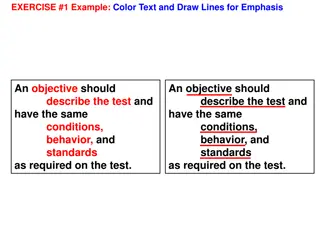
Assessing Systemic Lupus Erythematosus Activity: The Wolfe Index
In this study, a novel multimodal outcome instrument, the Wolfe Index, is proposed to assess systemic lupus erythematosus (SLE) activity and severity. The research aims to address the limitations of current assessment tools by developing a more accurate and comprehensive measure of SLE disease activity. Initial derivation and validation of the Wolfe Index are discussed, emphasizing the need for a tool that captures the full spectrum of SLE manifestations for improved clinical trials and treatment evaluation.
Download Presentation

Please find below an Image/Link to download the presentation.
The content on the website is provided AS IS for your information and personal use only. It may not be sold, licensed, or shared on other websites without obtaining consent from the author. If you encounter any issues during the download, it is possible that the publisher has removed the file from their server.
You are allowed to download the files provided on this website for personal or commercial use, subject to the condition that they are used lawfully. All files are the property of their respective owners.
The content on the website is provided AS IS for your information and personal use only. It may not be sold, licensed, or shared on other websites without obtaining consent from the author.
E N D
Presentation Transcript
Proposal of a Novel Multimodal Outcome Instrument for Assessing Proposal of a Novel Multimodal Outcome Instrument for Assessing Systemic Lupus Erythematosus Activity and Severity: Initial Systemic Lupus Erythematosus Activity and Severity: Initial Derivation and Validation of the Wolfe Index Derivation and Validation of the Wolfe Index Barbara Jacobs Barbara Jacobs1, 1,Francisco Espinoza Francisco Espinoza2, 2,Phildrich Teh Veena Ranganath Veena Ranganath4 4, Bevra Hahn , Bevra Hahn4 4and Kenneth Kalunian 1Div. Rheumatology, Allergy & Immunology, University of California, San Diego, USA 2 Universidad de los Andes, Santiago, Chile 3Div of Rheumatology, Scripps Health, 4Div of Rheumatology, University of California, Los Angeles, USA Phildrich Teh3 3, Gavin Flynn and Kenneth Kalunian1 1 , Gavin Flynn1 1, Jennifer Grossman , Jennifer Grossman4 4, Maureen McMahon , Maureen McMahon4 4, ,
Background Clinical scientists are consistently frustrated by the challenges of detecting a clinically meaningful change between treatment groups that delineates the efficacy of new therapeutics from conventional therapy.1-3 Currently used instruments designed to assess SLE disease activity have formidable pitfalls limiting their accuracy to detect such change: The British Isles Lupus Assessment Group (BILAG)-Index 4 misses critical laboratory features including dsDNA and complement levels, and under-representation of disease activity can happen if more than one manifestation within an organ system is present. Furthermore, it is rather cumbersome in use.In contrast, the SLE Disease Activity Index (SLEDAI) 5 and its derivate versions are fast and simple in use, but their clinical validity is limited by its dichotomous nature making it impossible to capture partial improvement in each organ domain. SLEDAI is heavily weighted towards neuropsychiatric and renal manifestations while missing other critical features including gastrointestinal involvement and hemolytic anemia. Such shortcomings have contributed to failure of the lupus community to demonstrate effectiveness of novel treatments. By understanding which aspects of current instruments are useful and by determining additional clinically pertinent criteria, our goal is to develop a novel disease assessment tool that more accurately captures SLE disease activity and serves as more relevant outcome measure in clinical trials for SLE.
Objective We herein describe the initial phase of development and preliminary validation of our novel instrument: the Wolfe-Index. We highlight future directions to further derive and validate this construct. Materials & Methods As initial exercise the authors of this poster including experts in the field of SLE outcome research, analyzed data from previous SLE trials and traditionally used outcome instruments and deconstructed these instruments to determine the relative merit of individual items of these instruments. Literature pertinent to SLE outcome research was reviewed using PubMed data base. Derived from these efforts, a preliminary construct of the Wolfe Index was created. For initial validation, a cross-sectional analysis in the UC San Diego SLE cohort was conducted comparing global scores of the Wolfe Index to SELENA-Systemic Lupus Erythematosus Disease Activity Index (SELENA-SLEDAI).
Results The overarching principle of the Wolfe Index is to achieve dynamic capturing of changes in disease activity and severity in a simple yet comprehensive fashion. The backbone of the Wolfe Index is grounded on traditional lupus descriptors describing visceral organ, musculoskeletal and mucocutaneous involvement as well as constitutional symptoms and serologic activity. Beyond that, the instrument incorporates the domains of Treatment Modifications to dynamically monitor treatment adjustments as additional measure of disease activity, as well as a Physician Global Assessment (PGA) scores (Figure 1). To achieve dynamic grading that allows longitudinal assessment over time, a scoring system that requires scoring of each descriptor in each domain was implemented. Only descriptors identified as essential features that reflect lupus activity were included; features describing damage accrual were not taken into consideration. Key differences between traditional instruments and the Wolfe Index are highlighted in Figure 2. Initial validation efforts showed good correlation between the Wolfe Index and SELENA-SLEDAI (r= 0.8, CI95% 0.63- 0.89, p< 0.001) (Figure 3).
Results Figure 2 Figure 2. . Key differences between the Wolfe Index and current disease assessment instruments. Figure 3. Figure 3. Cross-sectional analysis shows good correlation between SLEDAI and Wolfe Index (r= 0.8, CI95% 0.63-0.89). Figure 1. Figure 1. The initial construct of the Wolfe Index.
Conclusion Better instruments to measure SLE disease activity and severity are needed to help delineate the efficacy of novel therapeutics from conventional therapy. The Wolfe Index aims to enhance the conduct of clinical trials by enabling clinical scientists to utilize a less complex instrument that at the same time provides greater discrimination between interventions and serves as more relevant outcome measure in clinical trials for SLE. Further refinement of the initial construct of the Wolfe Index are underway including a Delphi approach to determine the set of criteria that provide optimal clinical significance. Furthermore, the longitudinal performance of the instrument will need to be investigated.
References [1] Askanase AD, Merrill JT. Measuring disease activity in SLE is an ongoing struggle. Nat Rev Rheumatol. 2019;15: 194 195. [2] Mahieu MA, Strand V, Simon LS, Lipsky PE, Ramsey-Goldman R. A critical review of clinical trials in systemic lupus erythematosus. Lupus. 2016;25(10):1122-1140. [3] Merrill JT, Manzi S, Aranow C, Askenase A, Bruce I, Chakravarty E, et al. Lupus community panel proposals for optimizing clinical trials: 2018. Lupus Sci Med. 2018;5(1):1 14. [4] Isenberg DA, Rahman A, Allen E, Farewell V, Akil M, Bruce IN et al. BILAG-2004: development and initial validation of an updated version of the British Isles Lupus Assessment Group s disease activity index for patients with systemic lupus erythematosus. Rheumatology (Oxford). 2005;44:902-6. [5] Gladman DD, Ibanez D, Urowitz MB. Systemic Lupus Erythematosus Disease Activity Index 2000. J Rheumatol. 2002;29:288-91.






















